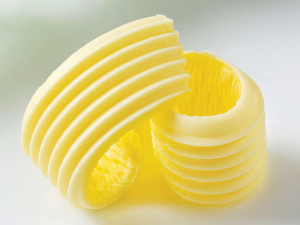Prices for milk fat are soaring and you can thank consumers worldwide for it.
 In June last year, butter prices on the Global Dairy Trade auction hovered about US$3000/tonne; the last auction on May 16 saw butter price reach nearly US$5500/t.
In June last year, butter prices on the Global Dairy Trade auction hovered about US$3000/tonne; the last auction on May 16 saw butter price reach nearly US$5500/t.
Anhydrous milk fat fetched US$3500/t in June last year; this month AMF fetched US$6600 on GDT.
BNZ economist Doug Steel says the high price of milk fat is due to supply and demand issues: dietary changes mean more consumers are eating butter.
“Fat isn’t seen as the bad thing it once was,” Steel told Dairy News.
While whole milk powder is the main driver of the payout, higher AMF and butter prices further lifted the forecast payout.
Former Fonterra director Mark Townshend says it is great news for all dairy farmers that milk fat prices are strong.
“Currently the net value of fat going into butter is roughly double the value of protein going into skim milk powder (SMP); this is a bit of an aberration, and fat will come back a bit and protein go up a bit in the future.
“The great news for dairy farmers is that good fat and good protein prices equal good incomes. [By contrast] sheepmeat prices are quite good but wool has a very low value; for sheep farmers to prosper they need good meat and wool prices.”
According to Townshend, 1kg of milk solids (MS) is roughly 55% fat and 45% protein; a good MS price needs good fat and protein prices.
“It is not worth increasing MS production if either of the two key components does not have value. A combination of strong fat and protein prices — also considering we produce more fat than protein — means farmers’ incomes will come roughly 70% from fat streams and 30% from protein this current season.”
Townshend notes that 20 years ago some industry leaders were suggesting the value of fat would be 10% of protein price, but they were proven wrong.
“Butter is now seen as a better option that margarine from a nutritional perspective… and sugar, not healthy fats, is seen as the primary villain in the obesity challenge.
“While fat is worth twice as much as protein today, what would be a reasonable assumption for the future? Only historians will get this right, but equal value for both protein and fat sort-of feels right, understanding that at some times there will be volatility in component relativity.
“All farmers, irrespective of their farming methods or cow genetics, should be very happy.”
Milk price always based on fat, protein – Fonterra
Fonterra chairman John Wilson says the co-op has always paid for fats and proteins.
“The payment for fat will be increasing relative to [prices] over the last couple of years. This is very carefully calculated; the price farmers get for the components of milk – fat and protein – is based on what market prices are, calculated on a three year rolling average.
“A lot of statistics go into it to ensure farmers are paid for what their product is worth in the market.”
Wilson says the co-op runs its plants efficiently and gets maximum utilisation based on where prices are now. And it has spent a lot on food service and UHT cream plant, all of it helping boost food service sales over the last 18 months.
“This is a critical part of the story as well,” Wilson says.
Strong demand for butter and AMF “reflects the understanding that the medical advice of three decades ago was flawed,” he says.
“We’re seeing [recognition of] the quality nutrition provided by dairy products, and strong demand from consumer and food service markets for these products. Butter prices, for example, are up 100% this year. Consumers globally are embracing high quality nutrition.”
Dairy fat is “seen to be a valuable part of our diet, as recognised by scientists and food experts globally, and consumers are demanding it”.
Source: Dairy News









